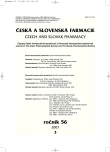Chitosan in topical preparations
Authors:
D. Matušová; E. Truplová
Authors‘ workplace:
Fakulta zdravotníckych špecializačných štúdií SZU v Bratislave, Katedra farmaceutickej technológie
Published in:
Čes. slov. Farm., 2007; 56, 141-145
Category:
Original Articles
Overview
Within the framework of experimental work at the Department of Pharmaceutical Technology of Slovak Medical University, “insect” chitin obtained from the buff-tailed bumblebee (Bombus terrestris) was processed to produce dosage forms and compared with commercially available chitin, or chitosan, obtained from shrimps (Pandalus borealus). The paper aimed to find whether insect chitin, or chitosan, possessed similar technological properties as commercially available and for topical preparations used products. Samples were prepared containing chitin, or chitosan, of different origin, 0.25 and 0.5 % in a gel base. In some gels the gel base was acidified with citric acid (in an amount of 0.75 %) or lactic acid (1 %) to improve the mechanical properties of foils. All samples were well applicable and after drying a relatively resistant transparent layer was formed on the skin. All samples could be made to produce elastic foils, which after moistening clung well to the skin. Both chitin and chitosan obtained from the bodies of buff-tailed bumblebees differed from reference materials obtained from shrimps by the degree of deacetylation, possessed different technological properties, e.g., finer fibres, were more fragile, and when wet, they could be disintegrated better, which is obvious also from the results of microscopic evaluation. Chitosan prepared from chitin SAV (insect) possessed substantially finer particles in the dosage form. The evaluation of the flow properties of the prepared samples revealed that except Sample I (gel base alone) they are timedependent tixotropic systems. Whereas chitin gels did not show any antimicrobial effect (which is apparently connected with bad solubility of chitin), gels with chitosan showed this activity. A more marked effect was observed in the strains of Staphylococcus aureus and Pseudomonas aeruginosa, and in Escherichia coli it was weaker. The paper reports the first tentative results of comparisons of chitin - and chitosan-containing gels obtained from insects and those obtained from shrimps, showing that the prepared samples were of comparable quality.
Key words:
chitin – chitosan – insects – shrimp – topical dosage form
Labels
Pharmacy Clinical pharmacologyArticle was published in
Czech and Slovak Pharmacy

2007 Issue 3
Most read in this issue
- Naphthoquinones and their pharmacological properties
- Thermoplastic granulation as an alternative method for the preparation of hydrophiliclipophilic oral matrix tablets
- Chitosan in topical preparations
- Medicinal preparations in a manuscript of a fifteen-century Franciscan monk in Brno
